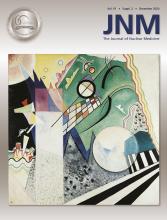We are not going to be the first to this party, but we are going to be the best.
—Steve Jobs
The initial tracer used to study bone metabolism (1,2) was the artificially produced radionuclide 32P. The tracer, made as described in the note below, was fed orally to rats. The tracer localized in multiple organs, with a preponderance in bone. 32P is a pure β-emitter and is not suitable for imaging human subjects. Table 1 lists some of the bone scan candidates, their physical half-life, and major photons that were considered for bone scanning. Although 99mTc was considered, it was in the form of pertechnetate, which did not have significant retention in bone. It was not until 1971 that Subramanian and McAfee discovered 99mTc-polyphosphate as a technetium-labeled agent that localized in bone.
Selected Bone-Seeking Radionuclides Circa Early 1960s
A major rationale for pursuing a tracer technique to image bone metabolism was to improve the sensitivity for detecting osseous metastases in patients with a diagnosis of cancer. Plain radiographs are relatively insensitive, requiring a lesion at least 1 cm in diameter and loss of at least 50% of bone mineral mass for lesion detection. Up to 40% of lesions are not identified on plain films (3). In these early days of nuclear medicine, several factors came together to permit the development of a high-sensitivity technique to detect osseous metastases. Benedict Cassen had developed an imaging device, the rectilinear scanner, in 1950. By 1965, several commercial vendors were selling improved versions of this instrument, including the Picker Corp. and Ohio Nuclear. A major improvement was the enhanced image quality of the photoscanner, as described by Kuhl et al. (4). The photoscanner provided an image on x-ray film that corresponded to the anatomic location of the tracer in the patient. The radionuclide scan could be directly correlated with radiographs.
Charkes and Sklaroff (5) built on the studies of Dow and Stanbury (6), which confirmed that “85Sr qualitatively parallels 45Ca as an index of skeletal function in metabolic bone diseases.” The 64-d half-life of 85Sr limits the intravenously administered dose to approximately 1,850 kBq (50 μCi). This low dose delivers a radiation burden of about 2.28 rad to bone. Because the photon flux from this dose is low, the area scanned was typically limited to the pelvis or spine. Even then, a scan would require about 30–45 min to record a single view. 85Sr is produced in a reactor, making it available at modest cost. 87mSr, on the other hand, was expensive and had to be prepared by milking the 87Y generator, and the user had to sterilize the eluate.
In the landmark report comparing 85Sr radionuclide bone scans to radiographs, Charkes and Sklaroff described the results of 85Sr bone scans in 90 patients with proven cancer and known or suspected bone metastases. The results of the bone scans were compared with orthoradiograms recorded at a 1.8-m (6-ft) distance. In 35 patients, both radiographs and bone scans were positive for tumor. In some patients, the scans demonstrated more extensive disease. Bone biopsies in 12 of these patients revealed tumor in the areas found to be positive on the scans. In 11 patients, the scan was positive and the radiograph negative. In 6 patients, the scan failed to detect a lesion seen on the radiograph. The scan for one patient was false-positive because the suspected lesion was due to tracer in the cecum, which overlaid the pelvis. Repeated scanning after bowel cleansing revealed that the lesion disappeared.
The authors observed positive scans in patients with both osteolytic and osteoblastic metastases. However, several patients with reticulum cell sarcoma metastatic to bone had negative scans.
These pioneering investigators could not have imagined the pivotal role they played establishing the clinical value of radionuclide bone scans. The ultimate development of tracers with a shorter half-life and better imaging characteristics, as well as the development of imaging devices that sample the whole body in a single procedure, continue to make the bone scan a valuable procedure for clinical care.
On a personal note, when I started my medical internship I was searching for a specialty. I visited Larry Silver, head of nuclear medicine at Queens General Hospital. Dr. Silver had an intensely positive 85Sr bone scan on a view box, next to the normal plain film of a patient with lung cancer. That scan showed me the power of nuclear medicine and the tracer technique. I was hooked.
NOTE
Georg Hevesy described how 32P was produced for the rat experiment (2). α-particles emitted from 222Rn, which was produced by the decay of 226Ra, produced a large number of neutrons. The neutrons irradiated a solution of carbon disulfide. The 32S in the carbon disulfide solution transmuted to 32P by the (n,p) reaction. After evaporation of remaining carbon disulfide, the 32P was concentrated and fed to the rats.
DISCLOSURE
No potential conflict of interest relevant to this article was reported.
- © 2020 by the Society of Nuclear Medicine and Molecular Imaging.
REFERENCES
- Received for publication May 5, 2020.
- Accepted for publication May 7, 2020.







